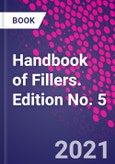Handbook of Fillers, Fifth Edition discusses the rapidly advancing field of fillers, the substances added to plastics and composites that add value by improving and modifying the properties of materials and reducing costs. This new edition is an essential reference for engineers and scientists using fillers in a range of materials, including plastics, rubber, adhesives, and paper. Designed to be a comprehensive reference for both experienced practitioners and those new to the field, it covers available fillers and their properties, their effect on filled materials, their rheology and flammability, recycling considerations, and their use in practical applications.
The book offers a direct comparison of general-purpose fillers (micron-size fillers) and nanofillers. The first section covers the grades of fillers available in the world market, dividing them into eight groups and analyzing their properties, applications, and sources. The second section discusses the effects of filler incorporation with ten chapters covering the mechanical properties of compounded materials, the effect of the filler on the material rheology, the morphology of the filled system, the material durability, flammability and recycling, the structure of interphase, chemical interphase, chemical interactions, interaction with and effect on other additive, fillers use in material compounds, and the analytical methods of testing fillers and filled materials. The final section is devoted to the application of fillers on an industrial scale. Filler transportation, storage, processing, and equipment used for these purposes are discussed, as are quality control of fillers, formulation with fillers, different processing methods, and health and safety issues.
Please Note: This is an On Demand product, delivery may take up to 11 working days after payment has been received.








